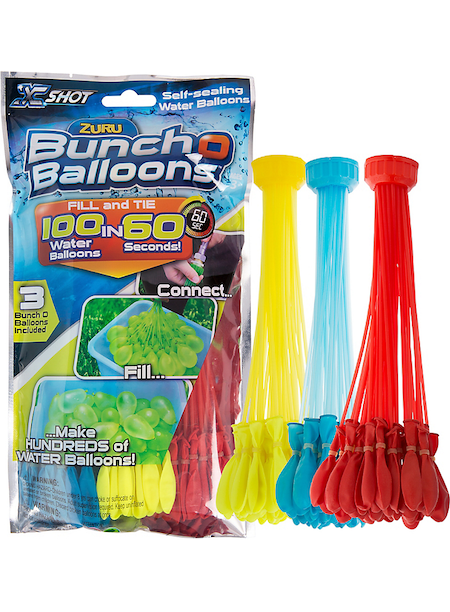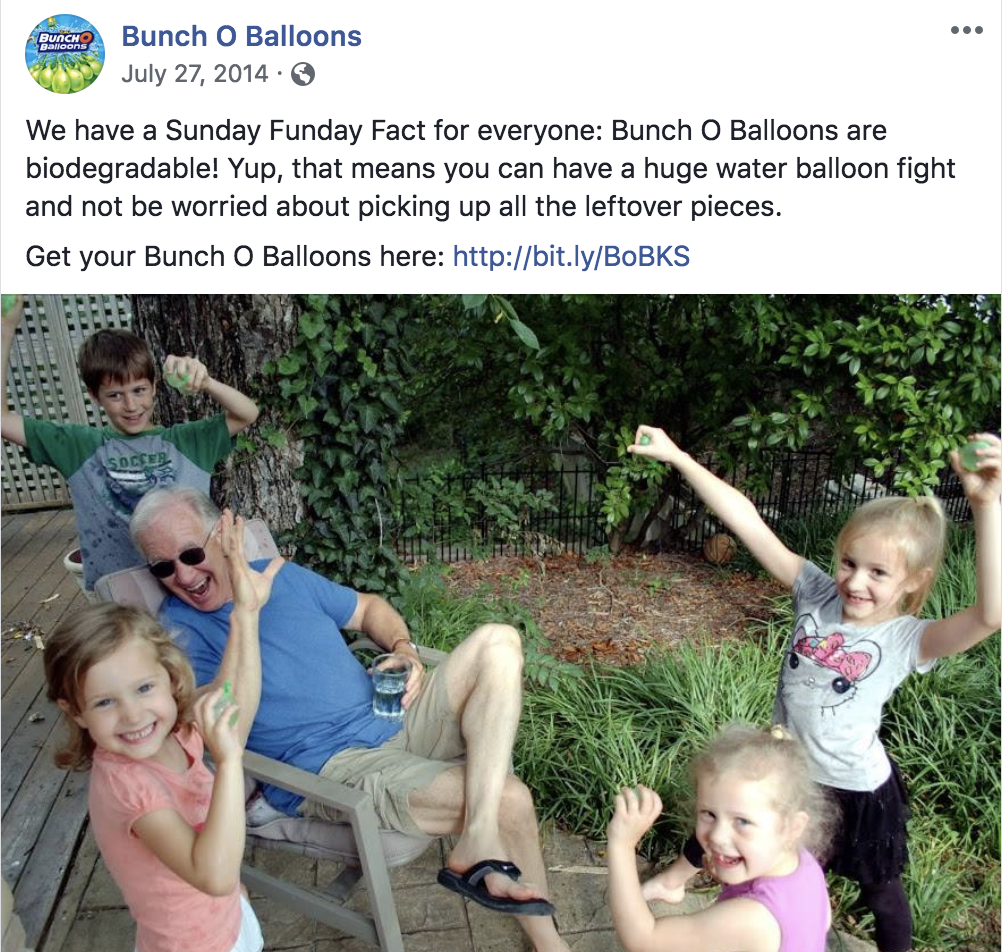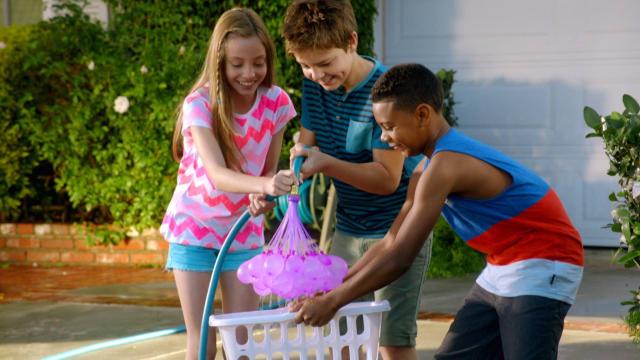How to fill up a water balloon in 1987: Stand at the bathroom sink, carefully pull the lip of the balloon around the faucet (there’s a 30% chance the balloon will tear at this point), turn on the water and watch the balloon expand, attempt to turn off the water at the balloon’s absolute maximum size (if you can let it grow as big as a butternut squash before it bursts, you are the hero of summer), wrap the neck of the balloon around your fingers until they turn blue, tie it and place it the bucket. Move on to Balloon No. 2.
How to fill up a water balloon now: Buy one of these crazy contraptions. Watch hundreds of balloons fill up and tie themselves before your eyes. Never understand your parents’ pain.

You’ve probably seen the magic of these newish instant water balloons – if not in real life, then at least on TV or YouTube or in a Facebook post by an amazed friend with young children. You simply screw a balloon “bunch” to the nozzle of a hose, turn on the water, and watch a multitude of fully formed water balloons drop into a bucket. It’s freakin’ magic (and ok, physics.) Toy company Zuru makes the original brand Bunch O Balloons.
The things are a hit with kids. I recently picked up a Costco pack of 420 balloons and my daughter and her friends had a water balloon fight in our backyard. It was epic, but so was the aftermath. I looked around at the hundreds of colourful balloon remnants that speckled the lawn. The next game of the day, of course, was “Let’s see who can pick up the most scraps!” (It was less of a crowd pleaser.)
We all made our best efforts at cleaning up, but I’m certain we didn’t get all the tiniest pieces (they were everywhere). I started wondering just how bad it would be if some remained out there. Bunch O Balloon’s FAQ states that the balloons and O-rings (the little rubber bands) are “biodegradable and environmentally friendly.” And then I came across this Facebook post (published four years back) by the company:

“You can have a huge water balloon fight and not be worried about picking up the leftover pieces.”
As a parent who dreaded spending the rest of the evening hovering over with lawn with a magnifying glass and trash bag, this was fantastic news. However, as a reporter and person who took environmental science in high school, I was sceptical. It sounded too good to be true.
I called Chris Reddy, senior scientist at Woods Hole Oceanographic Institution, a person who studies plastics and pollution. When I mention the company’s claim that we don’t need to pick up the pieces, he tells me: “I outright disagree with that statement.”
He explains that the company isn’t necessarily lying when they say their product is biodegradable — it may break down, eventually, but it’s “not a flick of a switch.” “My gut feeling is that if you left that balloon on a plain old grassy field, put a nail in so it wouldn’t blow away, and you came back a year later, it would still be there,” he says. In the meantime, that bit of balloon is pollution – it can threaten wildlife and be a choking hazard for babies and small children. And, Reddy believes, telling kids that they’re allowed to litter if something is biodegradable is a harmful approach. “You get into the attitude of saying, ‘It’s OK.’”
A few years ago, the Federal Trade Commission (FTC) set an environmental policy stating that products can no longer display the term “biodegradable” unless the product is proven to break down into natural elements within five years after disposal. But Reddy explains that companies often “game the system.” Microbes, he says, are only going to eat a balloon if it’s worth it to them. So if you put hungry microbes in a flask with just a balloon and no other food to eat, they will probably go for the balloon. But out in the real world, because there are many (probably more appetizing) options, that balloon may stick around for years and years.
Balloons Blow, an organisation that aims to “educate people about the destructive effects released balloons have on animals, people, and the environment,” bluntly calls Zuru’s Bunch O Balloons “single use crap.” Co-founder Danielle Vosburgh tells me “to suggest the mess doesn’t have to be picked up is highly irresponsible.” (We reached out to Zuru for comment, and will update this post if the company responds.)
Vosburgh, who has been studying plastic marine pollution for decades, says, “Balloons are the deadliest child’s toy. If a child accidentally inhales a bit or whole balloon, it is nearly impossible to remove, almost always resulting in death.” She shared with me this heartbreaking email she received from a parent just last night:
“10 days ago (May 31, 2018) my 9 month old died because he choked on a balloon. It was a water balloon that had not been blown up or popped. It completely blocked his airway making CPR unsuccessful. By the time EMT got to us it was too late. The day before this happened my older 3 boys were playing outside with the water balloons. One must have gotten tracked in and while crawling around my baby put it in his mouth. Parents think they will be able to do something if they see they’re child put a balloon in their mouth.
The reality is as quickly as they inhale, the balloon can disappear and you can’t do anything about it. I was right there with my son and I still couldn’t catch it in time before he aspirated the balloon. This tragedy has led me to take every step I can to try to find a way to warn everyone the dangers of balloons. In all ways balloons are a horrible invention. “
Vosburgh encourages people to use sustainable alternatives to water balloons – you can DIY a crocheted water balloon (or buy some on Etsy) or make sponge water bombs.
These options may not be quite as thrilling as watching hundreds of water balloons inflate like sorcery, but you avoid the many hazards of balloons, and the inevitable mess.

Comments
3 responses to “Are These ‘Biodegradable’ Water Balloons Really Biodegradable? ”
A better alternative is to do what we did back in the day that’s actually environmentally friendly and gets the kids involved in being art and crafty:
http://www.origami-instructions.com/origami-water-balloon.html
I am all for this – and thanks for the reminder – I haven’t seen one of these for decades!
With these, you not only encourage the creative process before you have the water fight, you teach the kids a few good lessons about economics (you can’t just grab another water balloon when you’re all out, you need to make them, and therefore need to be wise about how you use them), plus they’re much easier to clean up!
You and me both. I totally forgot about them until I read the article and it jogged my memory of 30+ years ago.
At the very least it keeps the kids busy for an hour while you have a coffee in peace 😀